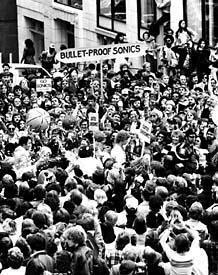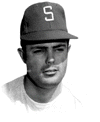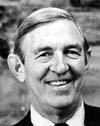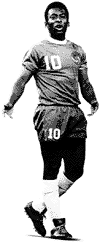By Sharon Boswell
and Lorraine McConaghy
Special to The Times

More than 300,000 people jammed city streets to cheer the Seattle
SuperSonics as they paraded through town after beating the Washington
Bullets for the 1979 NBA championship.
Photo Credit: Bruce McKim / Seattle Times.
WHEN A CITY HAS THE SIZE, THE ENTHUSIASM, THE MONEY AND THE PROPER SHOWPLACE,
it slips into long pants -- and becomes big league," wrote Times sports editor Georg N. Meyers in 1966.
Was Seattle ready to be a big-league city?
This question plagued local sports fans in the late 1960s and throughout the '70s as they tried to lure professional teams. Seattleites hoped to overcome a provincial reputation and the setbacks of the Boeing bust, and prove their city could support major-league franchises. To many, the question boiled down to image and resolve.
Size was not really an issue. King County's population had steadily increased, reaching well over a million by the end of the 1960s. The metropolitan area had become 18th largest in the country, and the great hinterlands beyond offered an even wider base of support.
But Seattle did not yet see it-self as a big-league contender. Initial attempts to bring pro football and baseball were still-born, and the National Hockey League could not generate enough enthusiasm to place a new team in the area.
In fact, the city got its first professional sports team almost in spite of itself when in 1966
the National Basketball Association, experiencing a surge of popularity and the threat of a
new, rival league, gave Seattle the first of eight expansion teams. But it was a pair of
Californians, Eugene Klein and Sam Schulman, who had enough faith in the city to invest
the $1.75 million required to start the new franchise.
The arrival of big-league basketball was also encouraged by the availability of a
suitable venue -- the 14,000-seat Coliseum, inherited from the World's Fair.
But the lack of an appropriate stadium stymied movements to acquire other sports franchises.
The idea of building a major-league arena had been intensely debated, and activists adopted
it as part of their efforts to reach a new "golden age" in Seattle. Citizens, led by Metro
patriarch James Ellis, initiated the Forward Thrust program, seeking funding for a
multipurpose stadium as well as rapid transit and other civic improvements. Although
voters rejected some higher-priced projects, more than 62 percent of them approved
stadium bonds of $40 million in 1968.
 The Pilots, Seattle's first Major League Baseball team, only lasted one season in 1969. They acquired,
then traded, outfielder Lou Piniella, left. But he returned to manage the Mariners in 1993. Photo Credit: Seattle Times.
The Pilots, Seattle's first Major League Baseball team, only lasted one season in 1969. They acquired,
then traded, outfielder Lou Piniella, left. But he returned to manage the Mariners in 1993. Photo Credit: Seattle Times.
NOTORIOUSLY TIGHT-FISTED PUGET SOUNDERS WERE UNDOUBTEDLY SPURRED to make this commitment
by progress in bringing professional baseball to the region. A few months earlier,
the American League had awarded an expansion franchise to Seattle. Two local boys,
Max and Dewey Soriano, with the backing of a Cleveland industrialist, had bid for
the team, then courted voters with a parade of baseball stars.
Seattle vested its big-league-baseball dreams in the Pilots when the franchise debuted
in 1969. And although the city greeted its newest professional team with almost naive
enthusiasm, that devotion could not be sustained.
Despite more than $1 million in renovations, venerable Sick's Stadium, longtime home to
Pacific Coast League baseball, did not measure up to big-league standards.
Ticket prices were high and the slipping economy turned people's attention from box scores
to unemployment figures.
In their first season, the Pilots drew only 677,000. With more than a million in attendance
needed to break even, the team declared bankruptcy and was sold to a Milwaukee group. Hoping to stop the sale, the city, county and state filed an antitrust suit against the league, seeking more than $82 million in damages.
But the legal battles did not end there. The new stadium, symbol of the city's sports future,
was held up by disputes over site selection. Wrangling got so bitter County Executive
John Spellman even faced a recall election. Construction, finally begun in 1972,
was plagued by more disagreements and delays.
 A local investor group headed by Lloyd Nordstrom, right,
brought professional football to Seattle. In their first year, 1976,
the Seahawks were sixth in the league in attendance, despite
a 2-12 record. Photo Credit: Seattle Times.
A local investor group headed by Lloyd Nordstrom, right,
brought professional football to Seattle. In their first year, 1976,
the Seahawks were sixth in the league in attendance, despite
a 2-12 record. Photo Credit: Seattle Times.
FINALLY, IN 1974, A LOCAL GROUP HEADED BY CLOTHING-STORE SCION
LLOYD NORDSTROM BROKE SEATTLE'S BIG-LEAGUE JINX, gaining National
Football League approval for an expansion team.
But what about baseball, which many felt was an essential step in the
city's march to the big leagues? With the lawsuit still pending, rumors
abounded that the baseball commissioner was trying to find the city a team.
Weekly, it seemed, The Times' sports pages mentioned another possibility.
The new stadium -- by now called the Kingdome -- was set for completion in spring 1976.
But it faced an uncertain future without a tenant like baseball, which would promise 70 to
80 home games. Then, just weeks before the planned opening, Seattle got word it had been
awarded an expansion team to replace the Pilots. The Mariners, under new owners Lester Smith
and Danny Kaye, brought professional baseball back to the region.
 World soccer superstar Pelé thrilled 60,000 local fans
in an exhibition match celebrating the opening of the Dome in 1976.
Photo Credit: Greg Gilbert / Seattle Times.
World soccer superstar Pelé thrilled 60,000 local fans
in an exhibition match celebrating the opening of the Dome in 1976.
Photo Credit: Greg Gilbert / Seattle Times.
THE INAUGURAL CELEBRATIONS FOR THE DOME HERALDED THE EXCITEMENT SEATTLEITES
FELT FOR THEIR ARRIVAL INTO THE BIG LEAGUES. The opening-night gala drew more
than 50,000 people curious to see the great new stadium. Record crowds also watched
the 1976 debut of the Seahawks and the Mariners' opening day the following spring. Now,
could the enthusiasm be maintained?
The SuperSonics had introduced major professional sports to Seattle,
yet had been overshadowed by the hoopla surrounding the city's fight for
other franchises. But in 1979 the Sonics once again led the way, winning
the NBA championship. As frenzied fans took to the streets to cheer Lenny Wilkens
and his team, there was little doubt that Seattle, at long last, was ready for the show.
Historians Sharon Boswell and Lorraine McConaghy teach at local universities and do research, writing and oral history. Original newspaper graphics courtesy of the Seattle Public Library.